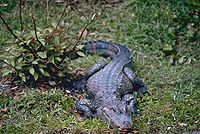
Photo from wikipedia
Nest materials are a major heat source due to rotting promoted by microbial activity. Additionally, they are a potential microbial source given their direct contact with eggshells. Microbial dynamics during… Click to show full abstract
Nest materials are a major heat source due to rotting promoted by microbial activity. Additionally, they are a potential microbial source given their direct contact with eggshells. Microbial dynamics during incubation have been studied in wild birds; however, similar studies in reptiles remain elusive. Here, the study characterized microbial communities in the nest materials of Chinese alligator (Alligator sinensis) using high-throughput sequencing of bacterial 16S rRNA genes and fungal internal transcribed spacer (ITS) region sequences. The results showed that significant changes in the diversity and structure of microbial communities according to different incubation periods. The diversity and richness of bacterial species increased significantly over time, but the relative abundance of the most dominant bacteria in pre-incubation period, including some pathogenic bacteria, declined after incubation. In contrast, fungal species diversity and richness decreased significantly with time. Additionally, nest material composition significantly influenced microbial community structure rather than species diversity and richness. Notably, the fungal community structure showed a stronger response than bacteria to nest material composition, which varied due to differences in plant litter composition. Our results demonstrate the significant response of microbial community diversity and structure to differences in incubation periods and nest material composition in reptiles. It is further emphasized that the importance of incubation period in the conservation of the Chinese alligator and could inform similar studies in other reptiles and birds.
Journal Title: Frontiers in Microbiology
Year Published: 2022
Link to full text (if available)
Share on Social Media: Sign Up to like & get
recommendations!